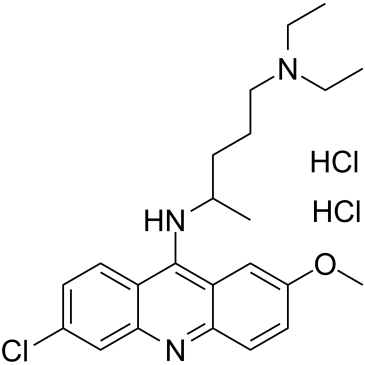Quinacrine dihydrochloride |
| Catalog No.GC61229 |
Quinacrine (Mepacrine) dihydrochloride is an orally bioavailable antimalarial agent, which possess anticancer effect both in vitro and vivo.
Products are for research use only. Not for human use. We do not sell to patients.

Cas No.: 1969/5/6
Sample solution is provided at 25 µL, 10mM.
Quinacrine (Mepacrine) dihydrochloride is an orally bioavailable antimalarial agent, which possess anticancer effect both in vitro and vivo. Quinacrine dihydrochloride suppresses NF-κB and activate p53 signaling, which results in the induction of the apoptosis[1].
Quinacrine (5-20 μM; 24 hours) inhibits the growth of SGC-7901 cells[1].Quinacrine (7.5 and 15 μM; 24 hours) induces apoptosis in SGC-7901 cells, which is associated with mitochondria-dependent signal pathway and involves p53 upregulation and caspase-3 activation pathway[1].Quinacrine (15 μM; 24 hours) treatment significantly increased the levels of proapoptotic proteins, including cytochrome c, Bax, and p53, and decreased the levels of antiapoptotic protein Bcl-2, thus shifting the ratio of Bax/Bcl-2 in favor of apoptosis [1]. Cell Viability Assay[1] Cell Line: SGC-7901 cells
Quinacrine (100 mg/kg three times per week for two consecutive weeks) significantly suppresses circulating blast cells at days 30/31 and increases the median survival time (MST). Quinacrine does not decrease the body weight of treated animals at the tested dose[2]. Animal Model: Female SCID mice with acute myeloid leukemia (AML)-PS model[2]
[1]. Xiaoyang Wu, et al. Quinacrine Inhibits Cell Growth and Induces Apoptosis in Human Gastric Cancer Cell Line SGC-7901. Curr Ther Res Clin Exp. 2012 Feb;73(1-2):52-64. [2]. Anna Eriksson, et al. Towards repositioning of quinacrine for treatment of acute myeloid leukemia - Promising synergies and in vivo effects. Leuk Res. 2017 Dec;63:41-46.
Average Rating: 5 (Based on Reviews and 11 reference(s) in Google Scholar.)
GLPBIO products are for RESEARCH USE ONLY. Please make sure your review or question is research based.
Required fields are marked with *




















